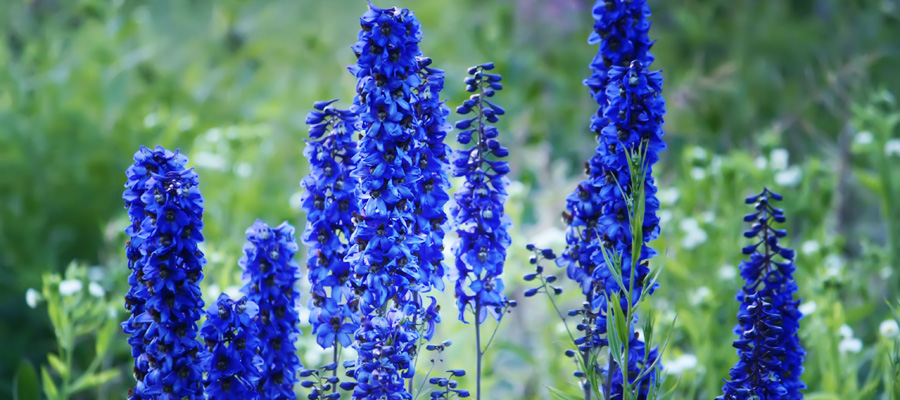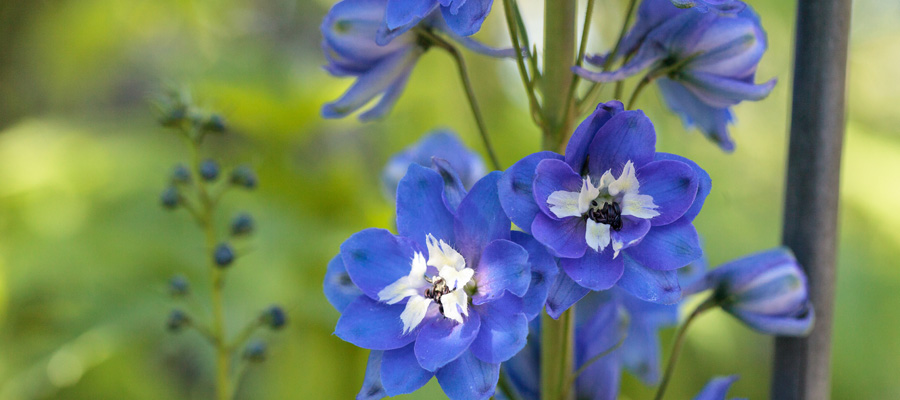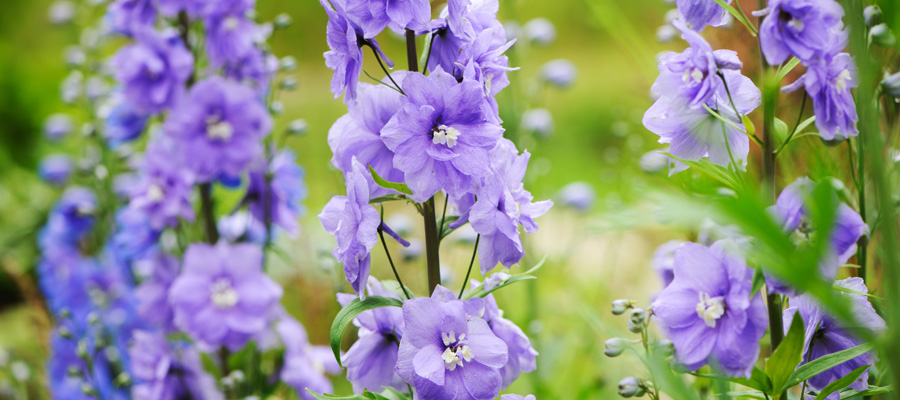
Common Names
- Larkspur
- Annual Larkspur
- Rocket Larkspur
Note on taxonomy: “Larkspur” in gardens usually means annual Consolida (airy, finely cut foliage, single spires). Delphinium are typically perennial, chunkier plants with broader leaves. Some modern classifications fold Consolida into Delphinium, but florists still distinguish them for their look and cultivation.
Scientific Name
Consolida spp. (often sold as Delphinium larkspur in the cut-flower trade)
Family & Genus
- Family: Ranunculaceae
- Genus: Consolida (syn. Delphinium in some treatments)
Description

Feathery, finely dissected foliage sends up slender wands packed with starry, five-petaled blooms, each with a backward “spur” that gives larkspur its name. Colors span clear sky blues, indigos, mauves, lilacs, rosy pinks, and crisp whites—often with a contrasting “bee” (the eye at the flower’s center). Plants are elegant and vertical (60–120 cm/2–4 ft), perfect for soft, meadowy compositions and airy bouquets.
Habitat & Origin
Native to the Mediterranean and western Asia, annual larkspur thrives in mild, dry summers and cool springs. It prefers full sun and well-drained, moderately fertile soil; excessive nitrogen pushes foliage over flowers.
Symbolism & Meaning
- Lightness & levity: their buoyant spires suggest cheer and openheartedness.
- Sweet disposition & grace: traditional Victorian floriography.
- July birth flower: joy, positivity, and steadfast affection (often paired with Delphinium).
Uses
- Ornamental: cottage gardens, naturalistic borders, and wildflower drifts.
- Cut flower: long, elegant stems; excellent for hand-tied bouquets and tall arrangements.
- Dried flower: heads can be air-dried for everlasting designs (color holds best in shade).
Flower Care (Cut)
- Harvest when the lowest one-third of florets are open.
- Strip lower foliage, recut stems, and hydrate in deep, clean water with preservative.
- They’re thirsty—top up frequently. Vase life: approximately 6–10 days.
- For drying, hang small bunches upside-down in a dark, airy space for 10–14 days.
Cultivation & Garden Care
- Sowing: Direct-sow late autumn to very early spring; seeds love cool soils and may need a brief chill to germinate.
- Spacing: 20–30 cm to reduce mildew and promote straight stems.
- Support: In windy sites, corral with unobtrusive twine—stems are tall but slender.
- Water: Even moisture early; avoid waterlogging.
- Deadhead: Prolongs bloom and tidies the plants.
- Toxicity: All parts are poisonous to humans and pets; seedlings are especially dangerous to livestock.
Flowering Season

Late spring to midsummer in temperate climates; where summers are cool, flowering can extend into early autumn. In hot regions, best performance comes from fall or late-winter sowings for spring bloom.
Varieties & Garden Forms
- ‘Earl Grey’: Misty slate-lavender with a vintage vibe; superb for neutral palettes.
- ‘Giant Imperial’ Mix: Tall, classic florist blend in blues, pinks, and whites.
- ‘Sublime’ Series: Uniform stems and saturated blues/purples for cutting.
- ‘QIS’ Series: Bred for stem strength and productivity; a market-grower favorite.
- White forms: Often sold as ‘White King’ or ‘Snow Cloud’—essential for bridal work.
Interesting Facts
- The name “larkspur” references the flower’s backward spur, likened to a lark’s claw.
- Traditional dyers used certain larkspur and Delphinium relatives for blue tints.
- In meadow mixes, early sowings often self-seed, naturalizing gentle drifts year after year.
Images
Suggested images for this page:
- Close-up of spurred florets with contrasting “bee.”
- Full stems in gradient blues and whites.
- A dried bunch showing good color retention.








